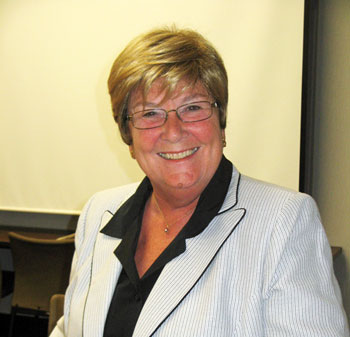At Michigan Theater, the organ prelude to screening of “Moonrise Kingdom” included Supertramp’s “Take the Long Way Home” and “Raiders of the Lost Ark” theme.
Archive for June, 2012
22nd Circuit Court: Four-Way Primary Race
This year, five local judicial seats will appear on the Nov. 6 ballot. Incumbents will be running for four of those positions, and three of those incumbent judges – Cedric Simpson (14th District Court, Washtenaw County); Joe Burke (15th District Court, Ann Arbor); and Darlene O’Brien (probate court, Washtenaw County) – are unchallenged.
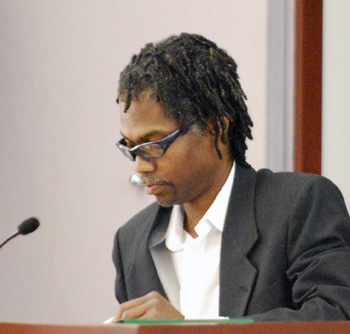
Mike Henry, co-chair of the Ann Arbor Democratic Party, moderated a June 23 judicial forum for the 22nd Circuit Court, hosted by the Washtenaw County Democratic Party. (Photos by the writer.)
The fourth incumbent – Tim Connors of the 22nd Circuit Court – is facing Mike Woodyard, an Ann Arbor resident and attorney in the Wayne County prosecutor’s office.
Another position on the 22nd Circuit Court is currently held by judge Melinda Morris, who is ineligible for re-election because of her age. The state constitution requires that judicial candidates at the time of election must be younger than 70 years old. The race for that non-incumbent judicial seat is a crowded one, with four candidates: Erane Washington, Doug McClure, Carol Kuhnke and Jim Fink. All four will be on the Aug. 7 primary ballot as non-partisan candidates, with the top two vote-getters facing off on Nov. 6.
On June 23, the Washtenaw County Democratic Party held a judicial candidate forum in Pittsfield Township hall. A previous Chronicle report covered the panel with Connors and Woodyard, as well as a presentation by 46th District Court judge Shelia Johnson, one of three Michigan Supreme Court candidates endorsed by the state Democratic Party.
This report focuses on the four-way non-incumbent race for 22nd Circuit Court. Questions covered a wide range of issues, including metrics for evaluating judicial performance, views on significant Michigan Supreme Court decisions, and descriptions of each candidate’s judicial philosophy and temperament.
Circuit court judges are elected to six-year terms and run as non-partisan candidates. But partisan politics was a significant part of this panel discussion, spurred in part by a handout had been placed on chairs in the audience prior to the start of the forum, titled ”What Washtenaw Democrats Should Know About Jim Fink.” [.pdf of handout text] At the start of the forum, Cleveland Chandler, chair of the Washtenaw County Democratic Party, announced that the WCDP had nothing to do with the handout, and the other three candidates made that same claim.
Some of the questions posed to candidates – specifically related to reproductive rights and the right for gay couples to adopt – highlighted the differences between Fink and the other candidates. With his Republican affiliations, Fink acknowledged during the forum that if this were a legislative race, ”you would not even think about voting for me.” But he vowed to follow the law and set aside his personal views as a judge, and noted that he has broad support from both parties, as well as ”people who don’t care about partisan politics at all.”
While not mentioning Fink directly, the other candidates noted that values do inform judicial decisions, and implied or stated directly that their positions on issues would align with those of Democrats. [Full Story]
Main & Washington
Bicycle-mounted Ann Arbor police officer apparently issuing ticket to motorist for failure to wear seatbelt. [photo]
First & Washington
Huge bus for American Red Cross blood drive parked in front of Allmendinger building.
Column: Remembering Bob Chappuis
You can read about Bob Chappuis’s heroics as a World War II tailgunner, or as a Michigan Wolverines tailback, just about anywhere – from his Time magazine cover story back in 1947, right up to his obituary in the New York Times last week. But my favorite stories are the ones he told his granddaughters.
I met Chappuis in 2000, while writing a story about his famous 1947 Michigan football team. But I really got to know him when I coached his grandson Bobby’s high school hockey team a couple months later. When Bobby went to Culver Academies for a post-grad year, I joined the family to see him graduate in 2004.
We were all relaxing in a hotel suite, eating and drinking, when Chappuis’s teenage granddaughters, Amy and Jenny, goaded him to tell some of his stories. He could not refuse them, but he shared the stories you couldn’t find in the magazines, like when his father told him he could go to any school he wanted – except Ohio State.
Chappuis skipped the part about leaving college to volunteer for the Army, where he served as an aerial gunner on a B-25. But his son Rob interjected to explain how their granddad’s plane was shot down over northern Italy, forcing the crew to parachute behind enemy lines.
Chappuis waved it off. “Everybody says we’re heroes. But what kind of idiot wouldn’t jump from a burning plane?” [Full Story]
UM: Supreme Court
The Atlantic magazine interviews University of Michigan law professor Samuel Bagenstos about the U.S. Supreme Court’s decision to strike down part of the federal health care law related to an expansion of Medicaid: “The $64,000 question as to Medicaid is how many states are going to decide that they don’t want to cover this expanded population, even with the very substantial financial incentive. I think the bigger concern is for other cooperative federal spending programs. This is the first time the Supreme Court has ever invalidated a condition on federal spending on the grounds that it coerced the states. That’s a big deal. That’s a really big deal.” [Source]
22nd Circuit Court Race: Connors, Woodyard
Local and state judicial candidates were the focus of a June 23 forum hosted by the Washtenaw County Democratic Party.
Most of the two-hour session, held at the Pittsfield Township hall, was devoted to two 22nd Circuit Court races. Incumbent judge Tim Connors, who has served in that position since 1997, is being challenged by Mike Woodyard, an Ann Arbor resident and assistant prosecuting attorney for Wayne County.
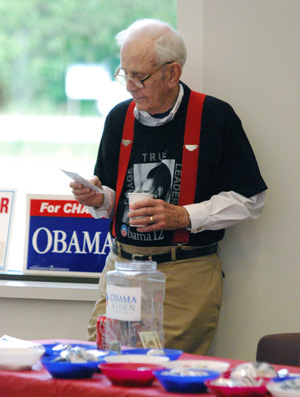
Doug Kelley, a longtime Ann Arbor Democratic activist and member of the Washtenaw County Democratic Party executive committee, at the June 23 judicial forum in Pittsfield Township. (Photos by the writer.)
There is no incumbent running for another seat on the 22nd Circuit Court – because judge Melinda Morris is ineligible for re-election as she is past the statutory age limit of 70. Four local attorneys are vying for that judgeship: Erane Washington, Doug McClure, Carol Kuhnke and Jim Fink. Coverage of that candidate forum will be provided in a separate Chronicle report.
The four candidates for the open 22nd Circuit Court seat will compete in the Aug. 7 primary to narrow the field. The two candidates in that race who receive the most votes will advance to the Nov. 6 general election.
All other local judicial candidates are incumbents who are unchallenged, and will appear on the Nov. 6 ballot: Cedric Simpson (14th District Court, Washtenaw County); Joe Burke (15th District Court, Ann Arbor); and Darlene O’Brien (probate court, Washtenaw County). They did not take part in the June 23 forum. These non-partisan judicial races are for six-year terms.
At the state level, candidates for Michigan Supreme Court are also on a non-partisan ballot, but they are nominated by political parties. Three positions on the seven-member court will be contested on Nov. 6, currently held by Democrat Marilyn Kelly and Republicans Stephen Markman and Brian Zahra, whose eight-year terms end on Jan. 1, 2013. Kelly is not seeking re-election because she’ll be past the age of 70. Markman and Zahra are running as incumbents, and the third GOP candidate will be selected at a state Republican convention in September.
In March, the state Democratic Party endorsed three candidates for Michigan Supreme Court: 46th District Court judge Shelia Johnson, Wayne County Circuit Court judge Connie Marie Kelley, and University of Michigan law professor Bridget Mary McCormack of Ann Arbor.
Of the three, only Johnson, a Southfield resident, attended the June 23 forum, telling the crowd of about 50 people that this year’s Michigan Supreme Court race is an historic election, and a chance to reverse the court’s current 4-3 majority. It’s the most important race on the ballot, she said, because the court’s decisions – from reproductive rights to environmental protection to emergency managers – affect everyone’s lives.
This article includes Johnson’s presentation at the June 23 forum, but begins with a report of the first 22nd Circuit Court race between Tim Connors and Mike Woodyard. [Full Story]
Briarwood Mall
Power outage. Stores Closing. Traffic lights out at Seventh & Scio Church, Main & Scio Church, Eisenhower & Main Street. [DTE power outage map]
AAPS Board Praises Superintendent
Ann Arbor Public Schools board of education regular meeting (June 27, 2012): After recessing to a five-hour closed session to conduct its first formal evaluation of AAPS superintendent Patricia Green, the board reconvened its regular meeting and unanimously voted to release a statement summarizing Green’s successes as she completes her first year with the district.
The board’s evaluation was uniformly positive, and counted among her successes the filling of vacant cabinet positions, dealing with funding cuts, helping to get the technology millage passed, and developing a strategy to address the “achievement gap.”
Green’s evaluation had included input from a set of roughly 70 community members suggested by board trustees. See previous coverage by The Chronicle on the evaluation’s structure and process: ”AAPS Begins Superintendent Evaluation.”
Green joined the district July 1, 2011, and is working under a five-year contract.
Also at their meeting, the board heard public commentary on two topics: second grade class sizes at Lawton elementary; and teacher release time used to support Skyline’s theatre program. [Full Story]
UM: Supreme Court
The University of Michigan Health System has issued a statement in response to today’s U.S. Supreme Court ruling on federal health care reform: “This ruling will ensure that more Americans will have health insurance and access to timely care – while reducing the burden of uncompensated care that we and other hospitals face.” [Source]
W. Huron & Chapin
Three cars and a motorcycle running red HAWK light when pedestrians still had 10 seconds to cross.
In the Archives: “Freedmen’s Progress”
Editor’s note: Laura Bien’s In the Archives column for The Chronicle appears monthly. Look for it around the end of every month or sometimes towards the beginning.
A recent Ward 1 Ann Arbor city council candidate forum included some discussion of the African American Cultural and Historical Museum of Washtenaw County, to be located on Pontiac Trail. In this month’s column, Bien takes a look at one piece of African American history with an Ann Arbor connection – the 50th anniversary of the ratification of the 13th Amendment to the U.S. Constitution.
Ann Arbor barber Henry Wade Robbins is one of many Washtenaw County residents singled out for commendation in a largely forgotten but historically invaluable book assembled in just three months in 1915. “Mr. Robbins has completely negated the popular fallacy that in order to be successful in the barber business the boss was required to draw the color line in his patronage,” says the work’s biographical entry for Robbins.
“This Mr. Robbins has never done. He treated all gentlemen alike and catered to high-class trade, both white and colored, and he has numbered and still numbers among his patrons many of the best-known white people in Michigan …” Robbins owned his own shop and its upstairs apartments at 117 Ann St. where he, his wife Martha, and their son and daughter lived.
The book’s data on employment, home ownership, and achievements by black Michiganders was collected and compiled by a panel of Michigan African Americans selected by Michigan governor Woodbridge Ferris. Their work was compiled into the “Michigan Manual of Freedman’s Progress” (MMFP), which offers a cross-section of successful black Michiganders in the early 20th century. [Full Story]
Design for Allmendinger Park Mural OK’d
The design for a mixed-media mural on pillars at the Allmendinger Park building was approved by members of the Ann Arbor public art commission at their June 27, 2012 meeting. [.pdf of mural design]
AAPAC selected Ann Arbor muralist Mary Thiefels of TreeTown Murals for the project at its Jan. 25, 2012 meeting. The final design has been changed from her original proposal, based on feedback from a mural task force, and is more abstract than the original. An initial $10,000 budget later had been increased to $12,000, with $7,200 of that amount to be paid for with a grant from the Ann Arbor Area Community Foundation.
Thiefel’s project includes working with local schools and incorporating ideas from students into her design – … [Full Story]
Washtenaw: Doug Harvey
The Ann Arbor District Library staff has posted an interview with former Washtenaw County sheriff Doug Harvey, part of a series of AADL podcasts on local history. A brief description of the interview states that “Harvey shares his memories of the turbulent 1960s in Ann Arbor and Ypsilanti. He recalls some of the personal, political, and law enforcement challenges he encountered during his years as sheriff – from the 1966 UFO sightings and the South University Riots, to the Coed murders and the John Norman Collins case. He also responds to some of the controversy surrounding his reputation and he speaks candidly about the community leaders and colleagues he admired during these years – and those he did not.” [Source]
Seventh & Willow
Ward 1 City Council Race: Filling Sandi’s Seat
One of the first local candidate forums in the 2012 primary election season was held last week – for Ann Arbor Ward 1 city council Democratic candidates, Sumi Kailasapathy and Eric Sturgis.
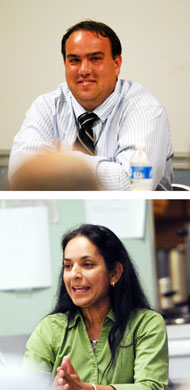
Eric Sturgis and Sumi Kailasapathy at their June 20, 2012 Democratic primary forum. They are running for a Ward 1 Ann Arbor city council seat.
In the Aug. 7 primary, the two candidates will contest Sandi Smith’s seat on the council. Smith announced in April that she will not seek re-election to a third two-year term.
The June 20 forum included fairly standard opening and closing statements, and other questions that invited candidates to talk about themselves.
Sturgis emphasized the fact that he grew up in Ann Arbor and noted his connection to the Ann Arbor public schools; he liberally sprinkled through his remarks the names of several people who’ve endorsed him, including Sandi Smith.
Kailasapathy emphasized her educational background in political science and economics and her professional training as a certified public accountant.
Broader policy issues covered at the forum included: communication (transparency and dissemination of information); planning and development (African American Cultural & Historical Museum, Near North, 618 S. Main); and transportation (rail station, countywide transit). The candidates were also asked questions about employee health care, public art, medical marijuana, and the public schools.
The forum featured a combination of questions that had been prepared in advance, as well as some questions submitted by audience members on cards during the forum. Mike Henry, co-chair of the Ann Arbor Democratic Party, moderated the forum and declined to read some of the questions submitted from the audience on cards, calling them “unfair.” But toward the end of the event Henry allowed questions to be asked directly from the audience. Anne Bannister, the other party co-chair, was also on hand to help manage the forum.
A kerfuffle over campaign yard signs preceded the forum – as the two campaigns had difficulty reaching agreement on the appropriate placement of yard signs outside the venue, the Arrowwood Community Center. The center is located off Pontiac Trail about a half mile north of Barton Road.
And during the forum itself, the focus of the conversation at times veered away from substantive issues into associations that Sturgis and Kailasapathy may or may not have had with past candidates for office – locally and statewide. One of those past candidates was current Ward 2 city councilmember Jane Lumm.
In a comment emailed to The Chronicle, Lumm offered this perspective: “I was not at the debate the other night, but it sounds like some of the discussion was about who supported whom in past elections rather than exclusively focused on the issues and challenges facing the city. That’s unfortunate. Whether it’s beefing up public safety, or the strategies and decisions on county-wide transit and the passenger rail station, or service delivery efficiency, there are important city issues and that’s where the discussion ought to be.”
The detailed report of the forum below is organized thematically, not in chronological sequence. The report begins with a brief bit of internal Ann Arbor Democratic Party business, and is followed by the broader policy topics and other one-off policy questions. The various who-supported-whom issues are extracted into a separate, final section. [Full Story]
Huron & Fourth
A stack of office equipment on the sidewalk next to the Embassy Hotel on Tuesday – a staging area as the Arts Alliance moves from its office at 202 E. Huron to an office at the NEW Center on North Main. [photo]
UM: TV Haunting
An episode of the Syfy Channel’s School Spirits series – titled “Sorority House Terror” – tells a tale about a haunted sorority at the University of Michigan. The episode includes an interview with local historian Wystan Stevens. [Source]
Liberty btw Ashley & Main
Staff presenting Nina with a “Happy Closing the Store” cake at Acme Mercantile [photo]
Parks Group Acts on Skatepark, Millage
Ann Arbor park advisory commission meeting (June 19, 2012): Park commissioners took action on three items that now will likely be on the Ann Arbor city council’s July 16 agenda: (1) a contract for the design of a proposed Ann Arbor skatepark, (2) path renovations at Leslie Science & Nature Center, and (3) a parks millage renewal.
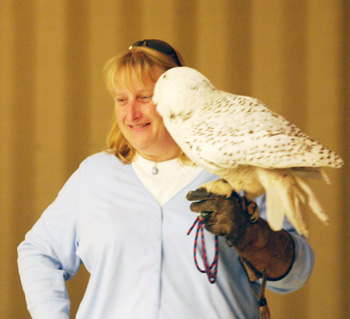
Francie Krawcke, raptor program director with the Leslie Science & Nature Center, brought a snowy owl to the June 19, 2012 meeting of the Ann Arbor park advisory commission. The owl did not fly around council chambers, but did enjoy a few snacks at the meeting. (Photos by the writer.)
An $89,560 contract with Wally Hollyday Skateparks – for design and construction oversight of a new skatepark at Veterans Memorial Park – was unanimously recommended for approval. Trevor Staples, president of the Friends of the Ann Arbor Skatepark, was on hand to answer questions, and several commissioners congratulated him for spearheading this project. Staples noted that fundraising is still underway, focused now on building a $100,000 endowment for future maintenance. Funding for design and construction of the skatepark has been secured primarily from a $300,000 state grant and $400,000 from the Washtenaw County parks & recreation commission.
PAC also unanimously recommended approval of a $115,309 contract with JB Contractors Inc. to build barrier-free pathways at the Leslie Science & Nature Center. The recommendation includes a 10% contingency, for a total project cost of $126,840.
This first phase of a broader renovation project on the center’s grounds will include making the raptor enclosures – housing owls, falcons, a bald eagle and other birds of prey – more accessible. The center, located at 1831 Traver Road, was previously part of the city’s parks system, but since 2007 has operated as an independent nonprofit. However, the city still owns and maintains the buildings and property.
Also unanimously recommended for approval was placement of a millage renewal on the Nov. 6 ballot. The current 1.1 mill Ann Arbor park maintenance and capital improvements millage expires this year. A renewal would run from 2013-2018 and is expected to generate about $4.9 million next year.
The June 19 meeting included a quarterly financial update, and the election of Tim Doyle as chair of PAC’s budget and finance committee. Commissioners also were briefed on a Traver Creek streambank stabilization project at Leslie Park golf course, designed to improve the water quality of this Huron River tributary.
Other water-related issues were brought up during the parks and recreation manager’s report. Colin Smith told commissioners that final repairs on swirl concentrators at West Park – designed to help stormwater management – will start later this month, with final renovations of the park occurring over the summer. And city staff will be harvesting Eurasian watermilfoil from about 6-7 acres around the Gallup Park canoe livery, using what Smith described as a “Zamboni on the water.” The aquatic plants have overgrown the area around the livery, making it hard for people to use paddleboats, canoes and kayaks.
During public commentary, Alan Haber urged commissioners to support the Library Green project, a citizen-led effort to put a public commons on top of the new city-owned Library Lane underground parking structure. He invited PAC to a July 14 “Imagine a Park” block party on the site, from noon until 5 p.m. Later in the meeting, park commissioner Tim Berla picked up the idea, saying he wasn’t advocating for that particular project but that he felt PAC should be “in the game” for discussions of a downtown park.
The June 19 meeting was the last one for commissioner David Barrett, who is term-limited after serving two three-year terms. PAC chair Julie Grand praised his work, particularly in advocating for renovations to the city’s athletic fields and ballparks. The mayor has not yet publicly put forward a nomination for Barrett’s replacement. [Full Story]
Church & Willard
Major renovation of East Quad underway, including new roof structure. (6/23/12) [photo]
Ann Arbor Absentee Ballots: First Wave
The Ann Arbor city clerk’s office has released the list of the first wave of absentee voters for the Aug. 7, 2012 primary election. The list includes the names and addresses of those voters who have applied to receive absentee ballots. This first wave is expected to be mailed on Wednesday, June 27. In the city of Ann Arbor the list totals 1,918 ballots, with the following breakdown by ward: Ward 1 (174); Ward 2 (558); Ward 3 (307); Ward 4 (451); and Ward 5 (428).
Candidates for public office often subscribe to the clerk’s absentee voter mailing list, which arrives in periodic installments by email up until the election takes place. Direct mail or door-knocking campaigns target absentee voter lists … [Full Story]
Stadium Blvd. & Arbordale
Demolition of Sze-Chuan West Restaurant. [photo] [Ann Arbor city planning commission recommendation from March 6, 2012 that includes construction of a Noodles & Co.]
UM: Public Universities
Former University of Michigan president Harold Shapiro is quoted in a Washington Post report about the role of public universities, in light of recent turmoil at the University of Virginia, where president Teresa Sullivan was asked to resign. [Sullivan is a former UM provost.] Shapiro states: “It’s very easy to focus on what’s popular or profitable. But corporations and universities have different social functions. State universities like Virginia need to ask the people of their state, do they really want a university of great quality?” [Source]
State Health Care Law Prompts AATA Debate
Ann Arbor Transportation Authority board meeting (June 21, 2012): Deliberations by Ann Arbor Transportation Authority board members were uncharacteristically animated as they discussed how to comply with a state-imposed limit on the amount that public employers can contribute to their employee heath care costs. Ultimately the 4-2 vote was to act now, not later, to impose a cap of 80% on the amount that the AATA will contribute to its non-union employee health care costs.

AATA board member Roger Kerson argues against immediate action on Act 152, which limits the amount that public employers can contribute to employee health care. (Photos by the writer.)
That action meets the requirements of last year’s state Act 152, signed into law in September 2011, which limits employer contributions to a fixed dollar amount. But Act 152 also allows for the governing body of a public entity – in this case, the AATA board – to vote to cap the employer contribution at 80%, leaving 20% to be covered by employees. And that’s what the AATA board did at its June 21 meeting. Dissenting on the vote were Charles Griffith and Roger Kerson, who felt that the timing was perhaps too early – because the contract for AATA’s unionized workforce goes through the end of the year.
Based on the way that some other transit agencies in Michigan had handled their Act 152 compliance, Griffith and Kerson felt it might be possible to delay action for its non-union staff until AATA was required to act on its union workers’ health care costs. That approach is based on the idea that all employees participate in the same health care plan. However, the advice of the AATA’s own legal counsel was that Act 152 doesn’t explicitly provide for that uniform treatment of employees, just because they participate in the same health care plan.
Kerson urged that the board consider taking the AATA’s “windfall” from its compliance with the state law and reinvesting in non-health care compensation. Just because the state had given public entities a hammer, Kerson said, did not mean that they had to use it against their employees.
In other board action, the expenditure of funds for planning a north-south commuter rail project – from Howell to Ann Arbor, known as WALLY – was authorized. The money had previously been included in the AATA’s approved budget for fiscal year 2012, which ends Sept. 30, 2012. But the board had passed a resolution that requires explicit board approval before the money in the budget could be expended. AATA’s portion of the $230,000 in planning costs is $45,000, with the remainder contributed by a range of other public entities – the federal government, the city of Howell, the Ann Arbor Downtown Development Authority, and Washtenaw County.
Another planning effort that’s moving forward did not appear as a voting item on the agenda, but was included in CEO Michael Ford’s written report to the board: continued study of a possible Ann Arbor transit connector for a corridor running from US-23 and Plymouth southward along Plymouth to State Street and further south to I-94.
The AATA received a $1.2 million federal grant for an alternatives analysis phase of the study – which will result in a preferred choice of technology (e.g., bus rapid transit, light rail, etc.) and identification of stations and stops. That federal grant comes with the requirement of a $300,000 local match, which now appears to have been secured in the form of $60,000 from the city of Ann Arbor; $150,000 from the University of Michigan; and $90,000 from the AATA itself. A feasibility study for the connector has already been completed.
In other action, the board authorized the purchase of five new lift-equipped vehicles for its paratransit service. The five vehicles will replace existing vehicles that have reached the end of their useful life.
Another non-voting item on the meeting agenda, but one that was included in the CEO’s written report, was news of a collaboration between AATA and the Ann Arbor Public Schools. Starting this fall, the AATA will provide transportation for three existing school bus routes – one for each of Ann Arbor’s comprehensive high schools – by extending existing AATA routes. AAPS will pay AATA $0.50 for each student who boards, which will be counted with a pass that can be swiped through the fare box. [Full Story]
Ann & Ashley
Electric car charging now available at the Ann & Ashley parking structure. [photo]
Main & Kingsley
Ex-Greek church on Main Street is on the foreclosure auction block. [photo]
Church & S. University
Copier “hearse” outside the (former?) course pack printer at Church and South U. [photo]
Main btw Washington & Liberty
Couple practicing dance moves to music played through tiny portable speakers. [photo]
Ingalls Mall
Sun Messengers rockin TOP. [photo]





